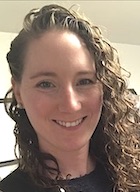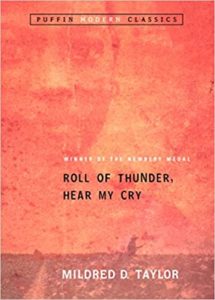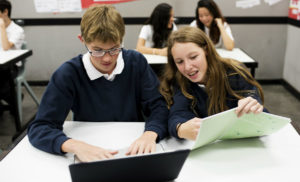Connecting Local History with Historical Fiction
By Katie Durkin
 Last year I happened to walk through our Library Learning Commons one day to witness an amazing lesson.
Last year I happened to walk through our Library Learning Commons one day to witness an amazing lesson.
Eighth grade students were examining primary source documents that discussed the history of enslavement in our Connecticut town. They were reading letters from townspeople, looking at paintings and images, and piecing together the role townspeople played as both enslavers and abolitionists. The town’s history even included a stopping point for The Underground Railroad.
I was fascinated by this information, and so were the students. Their conversations were engrossing as they grappled with their town’s history through both positive and negative lenses.
The 8th grade teachers at our public middle school were facilitating this lesson in collaboration with the director of our local historical society. It was by witnessing the power of this learning experience that I knew I wanted to bring local history into our historical fiction unit in 7th grade.
A Deep Dive into Historical Fiction
In 7th grade Reading, historical fiction is one of our biggest units of the year. Students begin this unit by reading Roll of Thunder, Hear My Cry as a whole-class novel and then embark on participating in book clubs where they read and study one particular time period in history they are interested in learning more about.
In their clubs, students read two historical fiction books of their choosing from the same time period, and also read articles, watch videos, and examine images to help them better understand the time period in which their characters are living.
While students are allowed to choose any historical time period, we provide multiple books for students to study The American Revolution, The Great Depression, World War II, The Civil Rights Movement, and September 11, 2001.
Wilton Historical Society’s then Assistant Curator Nick Foster introduces an historical document and the Revolutionary War in and around Wilton. More videos are available here.
Working with the Historical Society
To connect local history with historical fiction, my grade level team and I reached out to our historical society. Nick Foster, the Director of the Wilton (CT) Historical Society, was excited to once again work with our middle school students, as he often plans lessons and opportunities for our community’s children and young adults to learn more about our town’s history.
My grade level team and I first wanted to see if it was possible to do a lesson with all five time periods that are most popular with students. We pitched the idea to Nick that we wanted students to examine artifacts and primary source documents from their chosen time period in order to better understand their town’s role in history. Thankfully, Nick assured us that he would be able to help us do this work with our students.
Inviting Students to Focus on Wilton, CT

The first day will focus on Wilton in the 1930s. Because all of the students have read Roll of Thunder, Hear My Cry (which takes place in rural Mississippi in 1933), we want students to see what daily life was like in our New England town during the time period of a text they had read together.
During this lesson, students will be looking at primary source documents through a historical lens, collaborating with each other to determine what it was like to be in Wilton in the 1930s. By the end of this lesson, students will be asked to share what they learned about Wilton in that era and compare and contrast it with the deep-South world of Roll of Thunder, Hear My Cry.
Local Artifacts and Outside Impacts
The second day, students will have the opportunity to dive into their chosen historical period. Nick has done an amazing job gathering objects and artifacts for students to examine through a historical lens.
During this second session, students will be seeking to answer two more specific questions related to our essential question by examining primary sources and artifacts: (1) What do these objects tell us about the community of Wilton during… (insert historical time period)? and (2) What do these objects tell us about what is happening outside of Wilton during…(insert historical time period)?
These questions were created at Nick’s suggestion. From his perspective as a professional historian, he explained that if we want students to think about history, they need to approach “community” through both a macrocosmic and microcosmic lens. Nick shared that Wilton was a community that was making decisions in and of itself, but that there were people outside of the community on both a local, national, and global scale in all of these time periods who were making decisions that directly affected Wilton’s residents.
By looking through both these historical lens, our goal for the students will be to think about Wilton’s community during their time period at micro and macro levels. What was life like within the community, and how were its residents also affected by events happening outside of the community?
Collaborating to Reach Conclusions

Students will have the opportunity to collaborate with other small groups of students who are studying the same time period. They will also be asked in this work to finish the sentence: “Wilton, during the…(insert time period), is a community that…” This will help students to think about how they can synthesize what they’re learning about local, national, and global history.
Connecting History to Historical Fiction
The final day of this work will ask students to bring their new historical knowledge back to historical fiction. Students will be charged with trying to find connections with what they learned about Wilton’s history and their historical fiction stories.
Thinking through the lens of an author now, students will consider how authors use history to tell stories. We are hoping students will be able to connect some of the objects or primary sources with events, characters, or themes of their novels.
Reimagining the Project for Your Classroom
While my grade level team and I were fortunate enough to have Nick Foster from our historical society as an invaluable resource for this work, I believe any teacher could transfer this work into their own classroom, especially if you’re looking to infuse some local history into the curriculum.
Similar to our work, you can research and reach out to your local or regional historical society and Inquire if they have resources they could share with your students, especially primary sources.
Another option would be to do your own research as an individual teacher or a team. And a final option would be to have students do their own research about local history and share their findings. There are a lot of resources on the internet to help both teachers and students delve into their town’s history, and both Social Studies and English Language Arts classes could take on this work.
I’ll Be Back with Lessons Learned
I’m really excited to try out this lesson with our students. Historical fiction may be stories, but they are often inspired in whole or in part by the experiences of real people who lived through real and dark and difficult times.
I think by infusing local history with historical fiction, my students will be able to think about how authors are using history, doing research, and understanding the lives of their characters. I also think they will have a greater appreciation for their town and the role the townspeople who came before them had in history.
I am excited to embark on this journey with my students, and even more excited to learn more about our town’s local history. Stay tuned!
Dr. Katie Durkin (@kmerz610) has been teaching middle school students for over a decade, and currently teaches Reading Workshop at public Middlebrook School in Wilton, Connecticut, where she is the 7th Grade Team Leader.
Katie is a zealous reader of middle grade and young adult books and enjoys sharing her love and passion for reading with her students. In 2022 she earned her doctorate from Northeastern University, where her dissertation research examined the impact of classroom libraries on middle school students’ reading engagement.
She was the 2020 recipient of the Edwyna Wheadon Postgraduate Training Scholarship from the National Council of Teachers of English. She writes regularly for MiddleWeb.






























